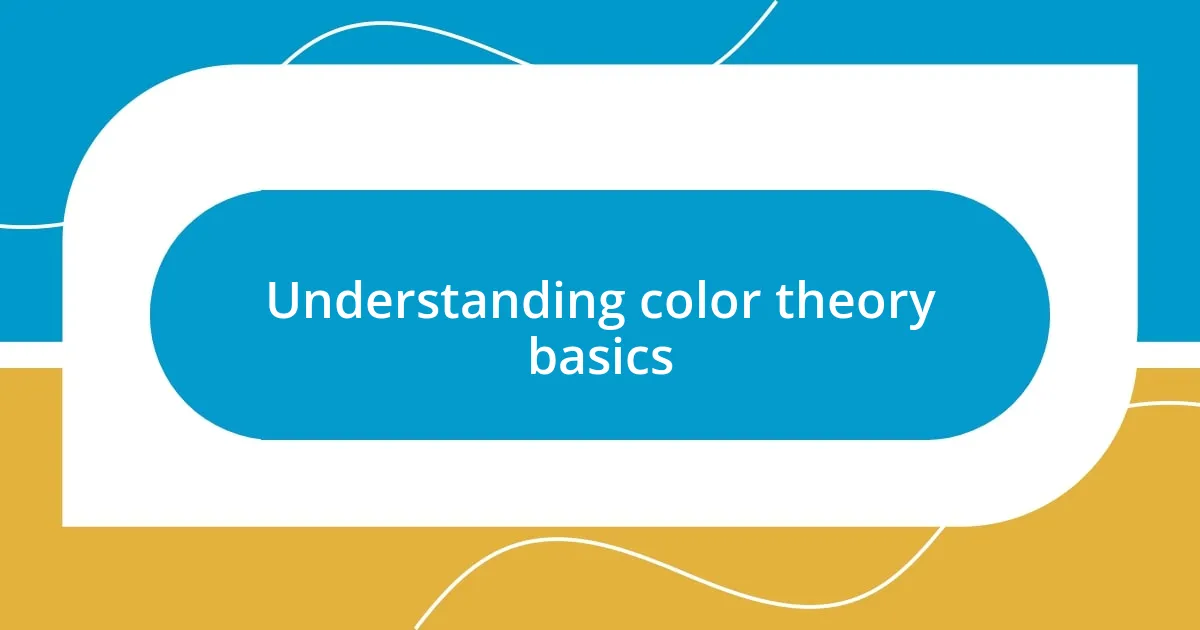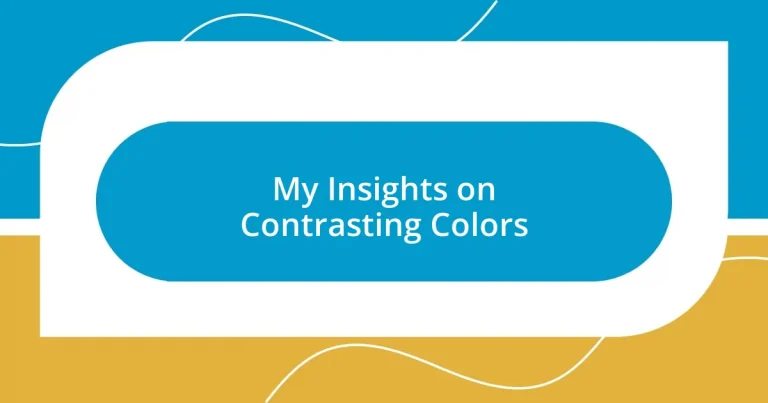Key takeaways:
- Color theory explores how colors affect emotions and perceptions, with primary and complementary colors enhancing visual impact.
- Contrasting colors can evoke strong emotional responses, create tension or harmony, and effectively grab attention in design.
- Techniques like establishing focal points, balancing color intensity, and incorporating texture can enhance the visual experience of contrasting colors.
- Applications of contrasting colors in art and design can transform spaces and convey powerful messages, impacting viewer engagement.

Understanding color theory basics
Color theory is more than just a collection of rules; it reflects how we perceive and interact with the world around us. When I first started exploring colors, I was amazed to realize how a simple change in hue could evoke different feelings. For instance, did you know that blue can often bring a sense of calm while red tends to stir up passion? This interplay is fascinating!
An essential aspect of color theory is understanding the color wheel, designed to illustrate the relationships between colors. I remember looking at the primary colors—red, blue, and yellow—and feeling a spark of creativity. It’s incredible how combinations of these colors can lead to secondary colors such as green, orange, and purple. Have you ever experimented with mixing colors? There’s a certain thrill when you see a new shade emerge from your brush.
Additionally, concepts like complementary colors genuinely capture my interest. These are colors located opposite each other on the color wheel, like blue and orange. I’ve found that using these pairs enhances visual impact, creating a dynamic and exciting aesthetic. Have you noticed how a pop of complementary color can completely transform an artwork or design? Exploring these basics has opened my eyes to endless possibilities in the world of color!

The psychology of contrasting colors
Understanding how contrasting colors impact our emotions is truly intriguing. When I first played with contrasting shades in my artwork, I noticed an immediate difference in the energy of the piece. For example, pairing a bright yellow with deep violet not only brought visual vibrancy but also stirred a sense of playful energy that I couldn’t ignore. Isn’t it fascinating how these contrasting palettes can communicate feelings without a single word?
In my experience, contrasting colors can generate a sense of tension or harmony, depending on how they’re used. While vivid contrasts like red and green can provoke strong reactions, softer contrasts such as pastel pink and mint create a feeling of calmness. I once designed a room using these softer contrasts, and the result was nothing short of rejuvenating. Did you know that our brains are wired to respond to contrasts in color, activating both emotional and cognitive reactions?
Contrasts also play a vital role in grabbing attention. I remember a project where I utilized black and white in graphic design. The stark difference between the two made specific elements pop and drew viewers’ eyes exactly where I wanted them to focus. By understanding the psychology behind these color combinations, I’m continually surprised by how effectively they can convey themes and messages.
| Color Pair | Psychological Effect |
|---|---|
| Red & Green | Intense, Vibrant, and Energetic |
| Blue & Orange | Dynamic, Exciting, and Balanced |
| Pastel Pink & Mint | Calm, Soft, and Fresh |
| Black & White | High Contrast, Focused, and Bold |

Examples of contrasting colors
When I think about contrasting colors, certain combinations immediately come to mind, enriching my understanding of their visual power. A personal favorite is the pairing of yellow and purple. I’ve often used this duo in my artwork, and the vibrancy can energize a room or even lift my mood. The sharp contrast between these colors draws attention like nothing else, making any design feel dynamic and alive.
Here are a few striking examples of contrasting colors that I find particularly captivating:
- Red & Teal: This pairing creates an exciting interplay, stimulating the senses.
- Navy & Coral: A classic mix that feels both sophisticated and lively.
- Black & Gold: The luxury of gold against dark black delivers a stunning, classy effect.
- Chartreuse & Magenta: This audacious combo could be overwhelming, yet it often leads to delightfully unexpected designs.
Every time I explore these combinations, I’m reminded of how contrasting colors not only elevate aesthetics but also evoke deep feelings and tell stories. It’s a fascinating journey!

Techniques for using contrasting colors
When incorporating contrasting colors, one effective technique is to establish a focal point. I once worked on a promotional poster where I used a bright orange to highlight the event details against a muted gray background. That orange just popped! It created an instant draw for anyone passing by, illustrating how a bold contrast can guide the viewer’s eye to essential information. Have you ever noticed how certain colors can immediately capture your attention?
Another approach I find essential is balancing the intensity of the colors. For example, in a recent room redesign, I opted for a deep navy blue on one accent wall paired with soft powder blue on the remaining walls. The intensity of the navy added depth, while the softer blue created a soothing environment. This taught me that even contrasting elements can work harmoniously when thoughtfully balanced.
I also love experimenting with varying textures alongside contrasting colors. During a recent art project involving brightly painted wooden blocks, I juxtaposed matte finishes with shiny metallics. The contrast wasn’t just visual; it added a tactile element that drew people in closer. Don’t you think it’s intriguing how the interplay of color and texture can enhance the overall experience?

Applications in design and art
When I think about contrasting colors in design, the impact can be profoundly exciting. I remember creating an interior mural where I used vibrant red against a soothing light green. The stark difference captivated everyone who saw it, transforming the space into a lively hub of creativity. Have you ever walked into a room and felt transported just by the colors on the walls?
Art galleries often harness the power of contrasting colors to engage visitors emotionally. During a trip to a contemporary gallery, I was struck by a piece that featured bold black and bright yellow. The contrast was so intense that it almost felt like a conversation between the colors, evoking a sense of urgency and energy. It made me wonder how much emotional resonance colors can create independently or in harmony with each other.
In graphic design, the strategic use of contrasting colors can effectively convey messages. I once designed a charity flyer, using a deep blue background paired with bright white text. This choice made the information easy to read while still feeling inviting. How do you think the choices we make in color can shape our connection to a piece of art or design? It’s moments like these that remind me of the profound impact colors have in our visual storytelling.

Enhancing visual impact with contrast
When incorporating contrasting colors, I’ve discovered that the emotional response of the viewer can be amplified significantly. I remember a fashion project where I paired a fiery red dress with a stark white backdrop. The contrast was striking and not only made the dress stand out, but it also seemed to exude confidence and boldness, almost challenging the viewer to take notice. Isn’t it fascinating how such color combinations can elicit strong feelings in us?
In my experience, the context of contrast matters just as much as the colors themselves. For instance, during a creative workshop I attended, we used yellow flowers in a blue vase for a centerpiece. The brightness of the yellow against the deep blue created a joyous atmosphere. It struck me how the setting changed completely with that simple contrast, enabling the participants to engage more freely. Does it ever make you think about how certain colors can warm a space or create distance, depending on how they’re used?
Working with contrast often leads to unexpected discoveries. I once experimented with a dark purple and a bright lime green in a digital art piece. The combination initially felt jarring, but as I adjusted the proportions, the artwork started to feel dynamic and alive. It dawned on me just how transformational contrast can be, pushing boundaries beyond our initial perceptions. Have you ever found that the most unusual color pairings can sometimes create the most enchanting effects?














